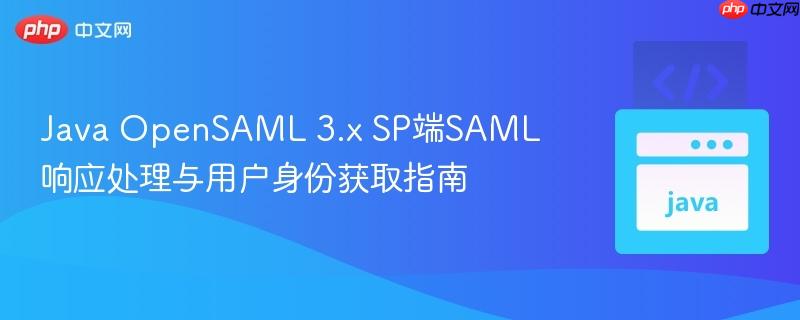
本教程详细介绍了使用opensaml 3.x在java ee/jsf应用中实现saml 2.0服务提供商(sp)的关键步骤,重点解决从身份提供商(idp)接收saml响应后无法获取用户身份的问题。内容涵盖opensaml组件初始化、正确构建并发送authnrequest(包括samlpeerentitycontext配置和nameidpolicy选择)、以及如何正确解析samlresponse并从断言中提取用户nameid,同时强调了消息签名和响应验证的重要性。
在基于SAML 2.0的单点登录(SSO)流程中,服务提供商(SP)与身份提供商(IDP)之间通过交换特定消息来完成用户认证。本文将深入探讨使用OpenSAML 3.x库在Java EE/JSF环境中实现SP端功能时,如何正确构建AuthnRequest并解析IDP返回的SAMLResponse以获取用户身份,尤其关注常见的配置陷阱和最佳实践。
在使用OpenSAML之前,需要初始化其核心组件,特别是XML解析器池和对象注册中心。这确保了SAML消息的正确构建和解析。
import org.opensaml.core.config.ConfigurationService;
import org.opensaml.core.xml.config.XMLObjectProviderRegistry;
import org.opensaml.core.xml.io.UnmarshallerFactory;
import org.opensaml.core.xml.util.XMLObjectSupport;
import org.opensaml.saml.common.binding.security.impl.MessageLifetimeSecurityHandler;
import org.opensaml.saml.common.binding.security.impl.ReceivedMessageIssuerSecurityHandler;
import org.opensaml.saml.common.binding.security.impl.ResponseAuthnContextSecurityHandler;
import org.opensaml.saml.common.binding.security.impl.SAMLProtocolMessageXMLSignatureSecurityHandler;
import org.opensaml.saml.common.xml.SAMLConstants;
import org.opensaml.saml.saml2.core.*;
import org.opensaml.saml.saml2.core.impl.*;
import org.opensaml.saml.saml2.metadata.Endpoint;
import org.opensaml.saml.saml2.metadata.SingleSignOnService;
import org.opensaml.security.credential.CredentialResolver;
import org.opensaml.security.credential.UsageType;
import org.opensaml.security.x509.X509Credential;
import org.opensaml.xmlsec.signature.Signature;
import org.opensaml.xmlsec.signature.support.SignatureValidator;
import org.opensaml.xmlsec.signature.support.impl.ExplicitKeySignatureTrustEngine;
import org.opensaml.xmlsec.signature.support.impl.X509CredentialKeyInfoCredentialResolver;
import org.opensaml.xmlsec.signature.support.impl.X509SignatureValidationParameters;
import org.slf4j.Logger;
import org.slf4j.LoggerFactory;
import org.w3c.dom.Element;
import net.shibboleth.utilities.java.support.component.ComponentInitializationException;
import net.shibboleth.utilities.java.support.xml.BasicParserPool;
import javax.annotation.PostConstruct;
import javax.inject.Named;
import java.io.File;
import java.io.IOException;
import java.io.StringReader;
import java.util.Arrays;
import java.util.Collections;
import java.util.HashMap;
import java.util.Map;
@Named
public class OpenSAMLUtils { // Renamed for clarity, assuming original SAMLAuthForWPBean contains this logic
private static final Logger LOGGER = LoggerFactory.getLogger(OpenSAMLUtils.class);
private static BasicParserPool PARSER_POOL;
@PostConstruct
public void init() {
if (PARSER_POOL == null) {
PARSER_POOL = new BasicParserPool();
PARSER_POOL.setMaxPoolSize(100);
PARSER_POOL.setCoalescing(true);
PARSER_POOL.setIgnoreComments(true);
PARSER_POOL.setIgnoreElementContentWhitespace(true);
PARSER_POOL.setNamespaceAware(true);
PARSER_POOL.setExpandEntityReferences(false);
PARSER_POOL.setXincludeAware(false);
final Map<String, Boolean> features = new HashMap<>();
features.put("http://xml.org/sax/features/external-general-entities", Boolean.FALSE);
features.put("http://xml.org/sax/features/external-parameter-entities", Boolean.FALSE);
features.put("http://apache.org/xml/features/disallow-doctype-decl", Boolean.TRUE);
features.put("http://apache.org/xml/features/validation/schema/normalized-value", Boolean.FALSE);
features.put("http://javax.xml.XMLConstants/feature/secure-processing", Boolean.TRUE);
PARSER_POOL.setBuilderFeatures(features);
PARSER_POOL.setBuilderAttributes(new HashMap<>());
try {
PARSER_POOL.initialize();
} catch (ComponentInitializationException e) {
LOGGER.error("Could not initialize parser pool", e);
throw new RuntimeException("Failed to initialize XML Parser Pool", e);
}
}
XMLObjectProviderRegistry registry = ConfigurationService.get(XMLObjectProviderRegistry.class);
if (registry == null) {
registry = new XMLObjectProviderRegistry();
ConfigurationService.register(XMLObjectProviderRegistry.class, registry);
}
registry.setParserPool(PARSER_POOL);
// OpenSAML 3.x 自动加载默认配置,无需手动初始化 DefaultBootstrap
}
public static <T extends XMLObject> T buildSAMLObject(Class<T> clazz) {
return (T) XMLObjectSupport.buildXMLObject(
ConfigurationService.get(XMLObjectProviderRegistry.class).getBuilderFactory().getBuilder(
ConfigurationService.get(XMLObjectProviderRegistry.class).getDefaultObjectProviderQName(clazz)
)
);
}
}AuthnRequest是SP向IDP发起认证请求的核心SAML消息。正确配置此请求对于SSO流程至关重要。
import org.joda.time.DateTime;
import org.opensaml.core.xml.XMLObject;
import org.opensaml.messaging.context.MessageContext;
import org.opensaml.saml.common.messaging.context.SAMLBindingContext;
import org.opensaml.saml.common.messaging.context.SAMLEndpointContext;
import org.opensaml.saml.common.messaging.context.SAMLPeerEntityContext;
import org.opensaml.saml.common.xml.SAMLConstants;
import org.opensaml.saml.saml2.core.AuthnRequest;
import org.opensaml.saml.saml2.core.Issuer;
import org.opensaml.saml.saml2.core.NameIDPolicy;
import org.opensaml.saml.saml2.core.NameIDType;
import org.opensaml.saml.saml2.metadata.Endpoint;
import org.opensaml.saml.saml2.metadata.SingleSignOnService;
import org.opensaml.saml.saml2.binding.encoding.impl.HTTPPostEncoder;
import net.shibboleth.utilities.java.support.component.ComponentInitializationException;
import net.shibboleth.utilities.java.support.resolver.ResolverException;
import org.apache.velocity.app.VelocityEngine;
import org.opensaml.messaging.encoder.MessageEncodingException;
import javax.servlet.http.HttpServletRequest;
import javax.servlet.http.HttpServletResponse;
import java.io.Serializable;
@Named
public class SAMLServiceProviderBean implements Serializable { // Renamed for clarity
private String idpEndpoint = "https://your.idp.com/sso/saml"; // 从IDP元数据获取
private String entityId = "https://your.sp.com/saml/metadata"; // SP的实体ID
private String assertionConsumerServiceURL = "https://your.sp.com/saml/acs"; // SP的ACS URL
// ... 其他注入和初始化代码 ...
public void createRedirection(HttpServletRequest request, HttpServletResponse response)
throws MessageEncodingException, ComponentInitializationException, ResolverException {
// 确保OpenSAMLUtils已初始化
new OpenSAMLUtils().init();
AuthnRequest authnRequest = OpenSAMLUtils.buildSAMLObject(AuthnRequest.class);
authnRequest.setIssueInstant(DateTime.now());
authnRequest.setDestination(idpEndpoint); // IDP的SSO端点
authnRequest.setProtocolBinding(SAMLConstants.SAML2_POST_BINDING_URI); // 使用HTTP POST绑定
authnRequest.setAssertionConsumerServiceURL(assertionConsumerServiceURL); // SP的ACS URL
authnRequest.setID(OpenSAMLUtils.generateSecureRandomId()); // 生成安全的随机ID
authnRequest.setIssuer(buildIssuer());
authnRequest.setNameIDPolicy(buildNameIdPolicy());
// 消息上下文配置
MessageContext context = new MessageContext();
context.setMessage(authnRequest);
// *** 关键修正点1: 配置SAMLPeerEntityContext指向IDP的SSO端点 ***
SAMLPeerEntityContext peerEntityContext = context.getSubcontext(SAMLPeerEntityContext.class, true);
SAMLEndpointContext endpointContext = peerEntityContext.getSubcontext(SAMLEndpointContext.class, true);
// 这里必须设置IDP的SSO端点,而不是SP自己的ACS URL
// 假设idpEndpoint是从IDP元数据中解析出来的SSO服务URL
endpointContext.setEndpoint(createIDPSingleSignOnServiceEndpoint(idpEndpoint, SAMLConstants.SAML2_POST_BINDING_URI));
// SAMLBindingContext 可选,用于指示编码器使用哪个绑定
SAMLBindingContext bindingContext = context.getSubcontext(SAMLBindingContext.class, true);
bindingContext.setRelayState(OpenSAMLUtils.generateSecureRandomId()); // 可选的RelayState
// 初始化Velocity引擎用于HTTP POST编码
VelocityEngine velocityEngine = new VelocityEngine();
velocityEngine.setProperty("resource.loader", "classpath");
velocityEngine.setProperty("classpath.resource.loader.class",
"org.apache.velocity.runtime.resource.loader.ClasspathResourceLoader");
velocityEngine.init();
// 编码并发送AuthnRequest
HTTPPostEncoder encoder = new HTTPPostEncoder();
encoder.setVelocityEngine(velocityEngine);
encoder.setMessageContext(context);
encoder.setHttpServletResponse(response);
encoder.initialize();
encoder.encode();
}
private Issuer buildIssuer() {
Issuer issuer = OpenSAMLUtils.buildSAMLObject(Issuer.class);
issuer.setValue(entityId);
return issuer;
}
// *** 关键修正点2: NameIDPolicy的选择 ***
private NameIDPolicy buildNameIdPolicy() {
NameIDPolicy nameIDPolicy = OpenSAMLUtils.buildSAMLObject(NameIDPolicy.class);
nameIDPolicy.setAllowCreate(true);
// 对于获取实际用户身份,不应使用TRANSIENT。
// UNSPECIFIED通常是一个好的起点,或者如果需要持久化标识符,可以使用PERSISTENT。
nameIDPolicy.setFormat(NameIDType.UNSPECIFIED); // 或 NameIDType.PERSISTENT
return nameIDPolicy;
}
private Endpoint createIDPSingleSignOnServiceEndpoint(String url, String binding) {
SingleSignOnService endpoint = OpenSAMLUtils.buildSAMLObject(SingleSignOnService.class);
endpoint.setBinding(binding);
endpoint.setLocation(url);
return endpoint;
}
// 辅助方法,用于生成安全的随机ID
public static String generateSecureRandomId() {
// 实现一个安全的随机ID生成器,例如使用UUID或SecureRandom
return java.util.UUID.randomUUID().toString();
}
}SAMLPeerEntityContext 配置: 在原始代码中,endpointContext.setEndpoint() 被错误地设置为SP自身的Assertion Consumer Service (ACS) URL。这导致OpenSAML认为AuthnRequest的目标是SP自身,而不是IDP。 正确做法:endpointContext.setEndpoint() 必须指向IDP的单点登录(SSO)服务URL,该URL通常从IDP的元数据文件中获取。这个端点是IDP接收AuthnRequest的实际位置。
NameIDPolicy 的选择: NameIDType.TRANSIENT 表示一个临时的、不持久的、不关联到特定用户的标识符,它在每次会话中都可能不同,因此不适用于获取用户的真实身份。 正确做法:为了获取一个可用于识别用户的身份,应使用 NameIDType.UNSPECIFIED(让IDP决定合适的格式)或 NameIDType.PERSISTENT(如果需要一个跨会话持久的假名)。
许多IDP会要求AuthnRequest进行数字签名以确保消息的完整性和真实性。如果IDP要求签名,必须在编码前对AuthnRequest进行签名。这通常涉及加载SP的私钥和证书,并使用OpenSAML的签名工具。
立即学习“Java免费学习笔记(深入)”;
// 示例:AuthnRequest签名(伪代码,需要完整的签名配置)
// import org.opensaml.xmlsec.signature.Signature;
// import org.opensaml.xmlsec.signature.support.SignatureConstants;
// import org.opensaml.xmlsec.signature.support.Signer;
// import org.opensaml.xmlsec.signature.support.impl.ExplicitKeySignatureTrustEngine;
// import org.opensaml.security.credential.Credential; // SP的私钥和证书
// import org.opensaml.security.credential.CredentialContext;
// import org.opensaml.security.credential.UsageType;
// import org.opensaml.security.x509.X509Credential;
/*
// 假设您已经有了SP的X509Credential (包含私钥和证书)
X509Credential spCredential = loadSPCredential();
Signature signature = OpenSAMLUtils.buildSAMLObject(Signature.class);
signature.setSigningCredential(spCredential);
signature.setSignatureAlgorithm(SignatureConstants.ALGO_ID_SIGNATURE_RSA_SHA256);
signature.setCanonicalizationAlgorithm(SignatureConstants.ALGO_ID_C14N_EXCL_OMIT_COMMENTS);
authnRequest.setSignature(signature);
try {
// 对AuthnRequest进行签名
XMLObjectSupport.marshall(authnRequest); // 必须先Marshall才能签名
Signer.signObject(signature);
} catch (SignatureException | MarshallingException e) {
LOGGER.error("Error signing AuthnRequest", e);
throw new MessageEncodingException("Failed to sign AuthnRequest", e);
}
*/当IDP完成认证后,它会将一个SAMLResponse POST回SP的Assertion Consumer Service (ACS) URL。SP需要解码此响应并从中提取用户身份。
import org.opensaml.messaging.decoder.MessageDecodingException;
import org.opensaml.saml.saml2.binding.decoding.impl.HTTPPostDecoder;
import org.opensaml.saml.saml2.core.Response;
import org.opensaml.saml.saml2.core.Status;
import org.opensaml.saml.saml2.core.StatusCode;
import org.opensaml.saml.saml2.core.Assertion;
import org.opensaml.saml.saml2.core.Subject;
import org.opensaml.saml.saml2.core.NameID;
import org.opensaml.saml.security.impl.SAMLSignatureProfileValidator;
import org.opensaml.xmlsec.signature.Signature;
import org.opensaml.xmlsec.signature.support.SignatureException;
import org.opensaml.xmlsec.signature.support.SignatureValidator;
import org.opensaml.xmlsec.signature.support.impl.ExplicitKeySignatureTrustEngine;
import org.opensaml.security.credential.Credential; // IDP的公共证书
import javax.servlet.http.HttpServletRequest;
public class SAMLResponseProcessor { // 假设这是一个处理SAML响应的类
private static final Logger LOGGER = LoggerFactory.getLogger(SAMLResponseProcessor.class);
public String processSamlResponse(HttpServletRequest request) {
// 确保OpenSAMLUtils已初始化
new OpenSAMLUtils().init();
HTTPPostDecoder decoder = new HTTPPostDecoder();
decoder.setHttpServletRequest(request);
try {
decoder.initialize();
decoder.decode();
MessageContext messageContext = decoder.getMessageContext();
// *** 关键修正点3: 接收的是SAMLResponse,而不是AuthnRequest ***
// 原始代码尝试将接收到的消息转换为AuthnRequest,这是错误的。
// IDP返回的是SAMLResponse。
Response samlResponse = (Response) messageContext.getMessage();
// 打印SAML响应以便调试
OpenSAMLUtils.logSAMLObject(samlResponse); // 假设OpenSAMLUtils有此方法
// 1. 验证SAML响应状态
Status status = samlResponse.getStatus();
if (status == null || !StatusCode.SUCCESS.equals(status.getStatusCode().getValue())) {
LOGGER.error("SAML Response status is not SUCCESS: {}", status != null ? status.getStatusCode().getValue() : "null");
return null; // 认证失败
}
// 2. 验证SAML响应签名(如果IDP对响应进行了签名)
// 假设您已加载了IDP的公共证书,并创建了相应的CredentialResolver
// CredentialResolver idpCredentialResolver = loadIdpCredentialResolver();
// ExplicitKeySignatureTrustEngine trustEngine = new ExplicitKeySignatureTrustEngine(idpCredentialResolver, new SAMLSignatureProfileValidator());
// if (samlResponse.getSignature() != null) {
// try {
// SignatureValidator.validate(samlResponse.getSignature(), trustEngine);
// LOGGER.info("SAML Response signature validated successfully.");
// } catch (SignatureException e) {
// LOGGER.error("SAML Response signature validation failed", e);
// return null; // 签名验证失败
// }
// } else {
// LOGGER.warn("SAML Response is not signed. Ensure this is acceptable per security policy.");
// }
// 3. 提取用户身份以上就是Java OpenSAML 3.x SP端SAML响应处理与用户身份获取指南的详细内容,更多请关注php中文网其它相关文章!

每个人都需要一台速度更快、更稳定的 PC。随着时间的推移,垃圾文件、旧注册表数据和不必要的后台进程会占用资源并降低性能。幸运的是,许多工具可以让 Windows 保持平稳运行。

Copyright 2014-2025 https://www.php.cn/ All Rights Reserved | php.cn | 湘ICP备2023035733号